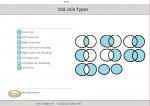hello All
I'm new here so please be kind if this sounds like garbage.
I am a *very* new access user - basically a one off as I have been put in a position where I need to use the system.
I have my database set up and an input form made, but I need some advice on how to do the following:
I need to create a gantt chart of types (using Qlikview) but in order for it to work I need to have some new data in my database. I have to have "phases" for each project. I don't think there is a sensible way to add this to my main data table, which is basically a list of each company, non duplicated, with associated data - (duplication would be needed for each phase but I think this would screw everything up I have already done).
What I believe is the best thing to do is to create a new table where each company is duplicated three times (for each phase) and then do a lookup of some sort to my main table to get the dates and use this to produce my chart.
My main question is - is it possible for this new table to lookup and automatically populate three new lines when a new company is added, so that the dates can be populated?
This may be over complicated and there is a better way to do this but I am not sure what that would be.
any help would be very much appreciated.:banghead::banghead::banghead:
Thanks
Drew
I'm new here so please be kind if this sounds like garbage.
I am a *very* new access user - basically a one off as I have been put in a position where I need to use the system.
I have my database set up and an input form made, but I need some advice on how to do the following:
I need to create a gantt chart of types (using Qlikview) but in order for it to work I need to have some new data in my database. I have to have "phases" for each project. I don't think there is a sensible way to add this to my main data table, which is basically a list of each company, non duplicated, with associated data - (duplication would be needed for each phase but I think this would screw everything up I have already done).
What I believe is the best thing to do is to create a new table where each company is duplicated three times (for each phase) and then do a lookup of some sort to my main table to get the dates and use this to produce my chart.
My main question is - is it possible for this new table to lookup and automatically populate three new lines when a new company is added, so that the dates can be populated?
This may be over complicated and there is a better way to do this but I am not sure what that would be.
any help would be very much appreciated.:banghead::banghead::banghead:
Thanks
Drew


